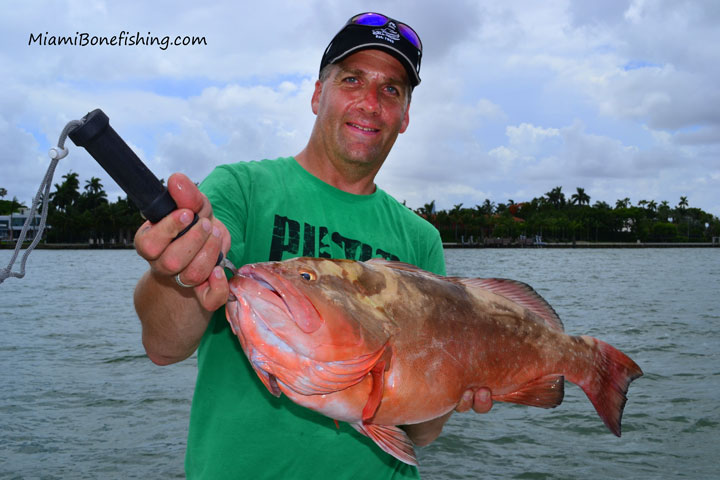Email:CaptMo@netzero.com | Tel:(786)853-1409 | BOOK A CHARTER
HOME CONTACT ABOUT CAPT. MO GALLERY VIDEOSBOOK A CHARTER MO'S FISHING REPORT TESTIMONIALS ABOUT BISCAYNE BAYABOUT CHARTERSLINKS
Permit
The Grouper
Winter time is prime time for grouper fishing in Miami’s Biscayne Bay and booking a Miami inshore fishing charter with Capt. Mo is the way to go. With local knowledge and a fun, professional attitude, Capt. Mo will make sure you have a good time while our shallow water groupers do their best to test your tackle. Give Capt. Mo a call today and see what shallow water grouper fishing is all about in Biscayne Bay.
Groupers, members of one of the largest families of fishes found in Florida waters, run the gamut of sizes and shapes,
from the diminutive graysby weighing several pounds to the mammoth goliath grouper (jewfish) that can tip the scales at 600 pounds or more.
Worldwide, there are over 400 species; 61 of these are in North America, and more than 40 are found in Florida waters. In general, groupers are oblong, large, and stout. Their small scales usually have a saw-toothed edge, and their fins are coarse and spiny. The massive, underslung jaws of these carnivores harbor strong teeth, and many species have two canine teeth at the front of each jaw. Three spines on each bony plate covering the gills require care when handling. Groupers, like chameleons, vary in color according to species, habitat, water depth, age, reproductive season, or stress. Four grouper species that are found in Florida are described below.
Black Grouper (Mycteroperca bonaci)
The black grouper has a vivid color pattern that includes brassy, bronze spots on the side of the head and body and, sometimes, dark, rectangular blotches running the length of the back. Its fins are bordered in black. Black grouper may reach over 4 feet and 180 pounds and have been seen forming spawning aggregations near the Florida Keys.
Gag Grouper (Mycteroperca microlepis)
The gag’s brownish-gray body is covered with thin, dark, wormlike markings often grouped in blotches that give the fish a marbled look. Its pelvic, anal, and tail fins are dark; the anal and tail fins sometimes have a white outer margin. It may reach over 4 feet and 70 pounds, but most are much smaller. Juveniles inhabit estuarine seagrass beds before moving into nearshore and offshore waters. Adults form spawning aggregations on offshore ledge habitats of the West Florida Shelf. The gag is often mistaken for black grouper.
Goliath grouper (Epinephelus itajara)
The giant of the grouper family, the goliath (formerly called jewfish) has brown or yellow mottling with small black spots on the head and fins and has a gargantuan mouth with jawbones that extend well past its small eyes. Its tail is rounded, and five irregular, dark side-bands are most visible on juveniles. They can reach whopping lengths of 8 feet or more, and the Florida record goes to a 680-pound goliath caught off Fernandina Beach in 1961. Once a popular target of fishermen, they are now protected from all harvest in Florida. They are opportunistic predators and feed mostly on slow-moving, bottom-associated species such as crabs. Goliath groupers, even juveniles, can make sounds and are known to make booming noises to warn off intruders. Goliaths are particularly noisy during the new moon.
One female goliath on display at The Florida Aquarium in Tampa has been seen sitting on her food when she is not hungry, presumably to prevent her tankmates from eating it.
Red Grouper (Epinephelus morio)
Red grouper are brownish red with scattered pale blotches, black dots around the eyes, and dark-tipped dorsal, anal, and tail fins. The membrane between the dorsal spines is not notched, and the tail fin is square. Red grouper are the most thoroughly studied of the Florida groupers. Using their mouths and fins, they remove sediment from the underlying hard bottom, creating pits that become home to other fish and invertebrates. Red grouper may grow to over 3 feet and average 10 pounds, though some reach 40 pounds. Red grouper can also produce sound.
Life History
Groupers can change sex, a relatively common occurrence among marine creatures. Some marine animals change from male to female, others (including some groupers) change from female to male, and some function as both at once. Although many grouper species are probably able to undergo a transformation from female to male, the incidence of individuals that do so is highly variable. Red groupers may change sex between 5 and 10 years old. Gag groupers may change at about 10 or 11 years old. Nassau groupers are able to change sex, although apparently few do. Scientists aren’t sure what natural advantage the sex change affords grouper or what specific factors trigger it. Some believe that in those species that live in groups, the death of the dominant male may prompt the largest female to change sex and become the dominant male in the hierarchy. However, some scientists believe that in grouper species that lead essentially solitary lives, the sex change is triggered when the fish gather to spawn.
Grouper species generally have distinct spawning seasons. For example, red grouper off Florida’s west coast spawn mainly in April and May. Gag grouper and scamp spawn offshore, principally from January through March, and are found to co-occur at depths over 180 feet. Goliath grouper spawn from July to October. However, in warmer waters of the southern Atlantic, Gulf of Mexico, and Caribbean, some grouper may spawn throughout the year. “Ripe” female black grouper in the Florida Keys, for instance, have been documented in all months.
All groupers are meat-eaters. Many eat fish and crustaceans, and larger goliath have been known to eat juvenile sea turtles. It is believed that many groupers do not actively search for prey but lie in ambush waiting for a suitable meal to swim near and then strike at it with lightning speed. Groupers maintain a mutually beneficial relationship with small “cleaner” fish and shrimp. A grouper will permit these tiny janitors to pluck dead tissue, parasites, and scales from its gills and body and even to enter its mouth to remove parasites. When a grouper wants to be “scrubbed,” it opens its mouth and assumes a nonthreatening position to attract its fastidious helpers.
Courtesy of the Florida Wildlife Commission
Scroll through the pics to the right to see some of Captain Mo's latest adventures:
It could be you posing with one of those beauties!
Book a charter today. All ages and skill levels welcome.
(786)853-1409.
Home | Contact | About Capt. Mo | Gallery
Mo's Fishing Report | Testimonials | About Biscayne Bay | About Charters | Links




